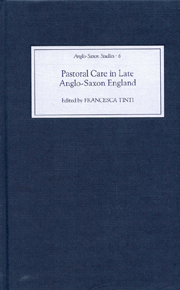Book contents
- Frontmatter
- Contents
- List of illustrations
- List of contributors
- Abbreviations
- Introduction
- 1 The clergy in English dioceses c. 900–c. 1066
- 2 The ‘costs’ of pastoral care: church dues in late Anglo-Saxon England
- 3 Ælfric in Dorset and the landscape of pastoral care
- 4 Is there any evidence for the liturgy of parish churches in late Anglo-Saxon England? The Red Book of Darley and the status of Old English
- 5 Remedies for ‘great transgressions’: penance and excommunication in late Anglo-Saxon England
- 6 The pastoral contract in late Anglo-Saxon England: priest and parishioner in Oxford, Bodleian Library, MS Laud Miscellaneous 482
- 7 Caring for the dead in late Anglo-Saxon England
- Index
Introduction
Published online by Cambridge University Press: 12 September 2012
- Frontmatter
- Contents
- List of illustrations
- List of contributors
- Abbreviations
- Introduction
- 1 The clergy in English dioceses c. 900–c. 1066
- 2 The ‘costs’ of pastoral care: church dues in late Anglo-Saxon England
- 3 Ælfric in Dorset and the landscape of pastoral care
- 4 Is there any evidence for the liturgy of parish churches in late Anglo-Saxon England? The Red Book of Darley and the status of Old English
- 5 Remedies for ‘great transgressions’: penance and excommunication in late Anglo-Saxon England
- 6 The pastoral contract in late Anglo-Saxon England: priest and parishioner in Oxford, Bodleian Library, MS Laud Miscellaneous 482
- 7 Caring for the dead in late Anglo-Saxon England
- Index
Summary
‘Pastoral care’ is not easy to define. The phrase can be stretched to accommodate different definitions, which obviously depend on the historical period for which it is used. In general terms it can be employed to refer to all the activities carried out by the clergy to assist and support the spiritual life of the laity. The adjective ‘pastoral’ derives from the image of the shepherd used in both the Old and the New Testaments as a metaphor for God's continuous love and care of His people. Sacraments have always had a special place among the activities and the liturgical celebrations which constitute pastoral care, although in the early Middle Ages the doctrine regulating them was still rather fluid. As will emerge from the articles contained in this volume, late Anglo-Saxon sources give special attention to baptism, penance and visitation of the sick. Pastoral care, however, also comprised other more common tasks and activities, such as preaching. It had a crucial role in so many important facets of people's lives that a study of this topic necessarily leads to a more general appreciation of the role of the Church in society as a whole.
The publication of this volume stems from one fundamental premise: late Anglo-Saxon pastoral care deserves to be studied for its own sake. For a long time, in fact, the evidence for tenth- and eleventh-century Church organisation and delivery of pastoral care has been treated as a useful tool to be employed regressively, that is, to try to reconstruct the situation in the earlier period, for which the evidence is noticeably scarcer.
- Type
- Chapter
- Information
- Pastoral Care in Late Anglo-Saxon England , pp. 1 - 16Publisher: Boydell & BrewerPrint publication year: 2005



